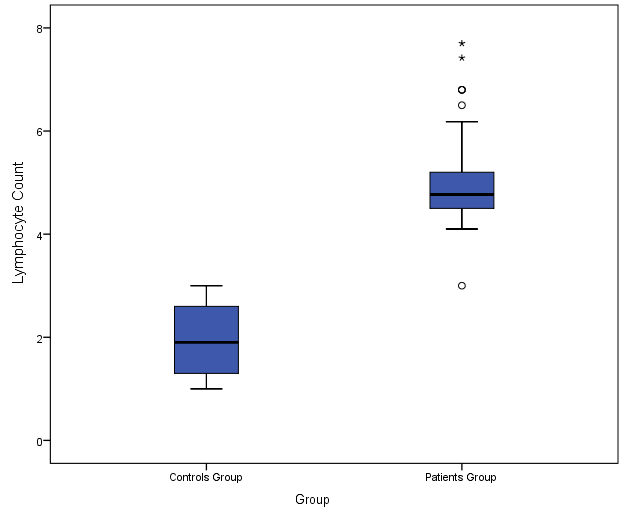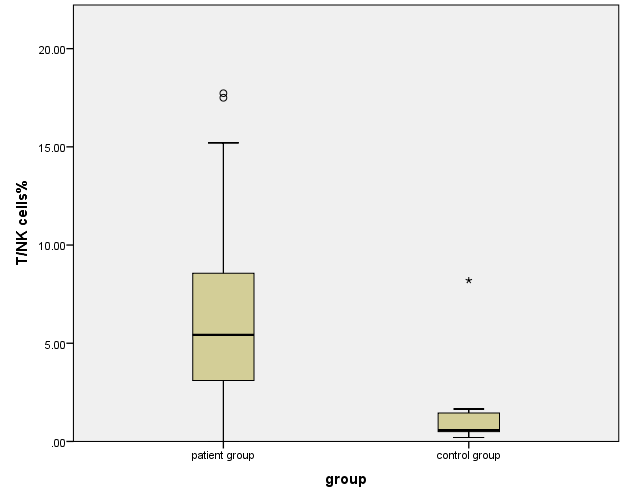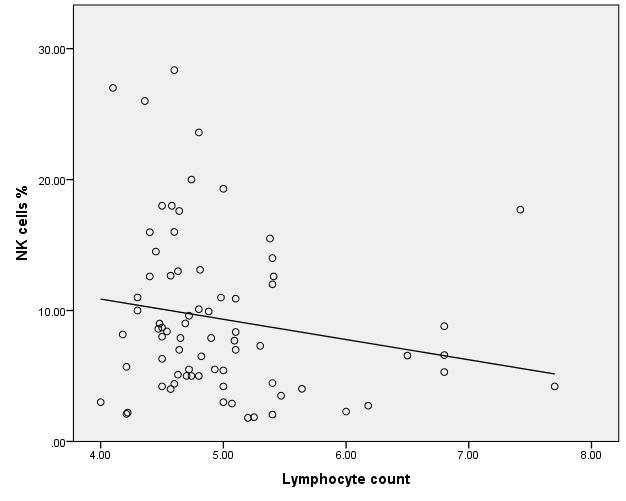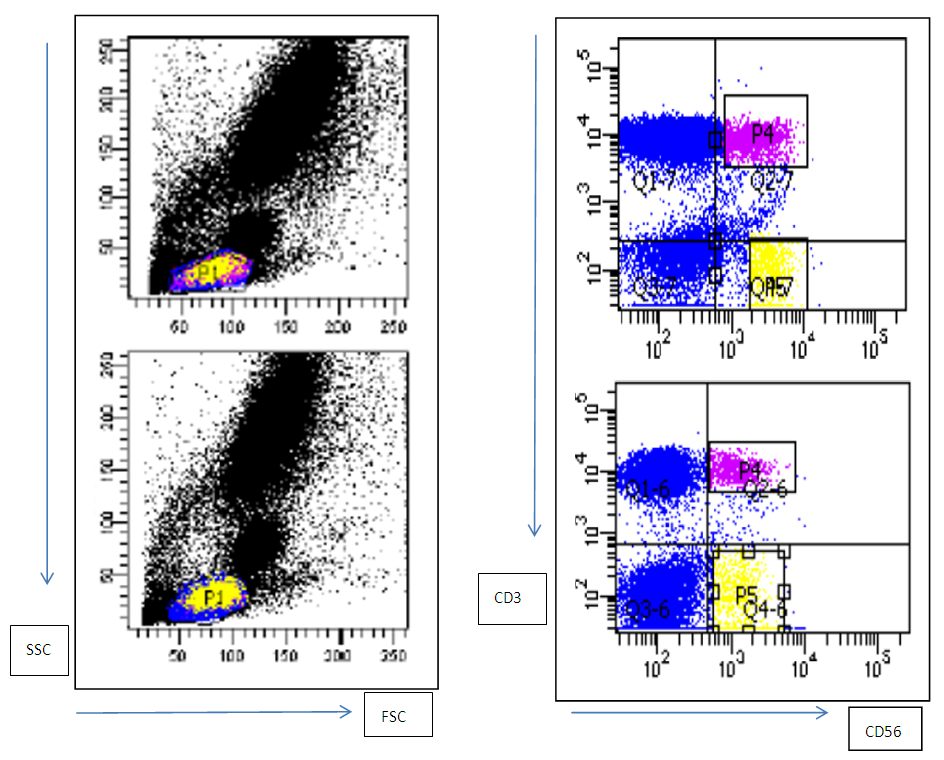-
Paper Information
- Paper Submission
-
Journal Information
- About This Journal
- Editorial Board
- Current Issue
- Archive
- Author Guidelines
- Contact Us
Clinical Medicine and Diagnostics
p-ISSN: 2163-1433 e-ISSN: 2163-1441
2019; 9(1): 1-7
doi:10.5923/j.cmd.20190901.01

Evaluation of NK and TNK Cells in Peripheral Blood of Adult Patients with Benign Lymphocytosis
Hanan A. EL-Hagrasy , Nagwa Hassanein
Clinical Pathology Department, Faculty of Medicine for Girls, Al-Azhar University, Cairo, Egypt (MD)
Correspondence to: Nagwa Hassanein , Clinical Pathology Department, Faculty of Medicine for Girls, Al-Azhar University, Cairo, Egypt (MD).
| Email: |  |
Copyright © 2019 The Author(s). Published by Scientific & Academic Publishing.
This work is licensed under the Creative Commons Attribution International License (CC BY).
http://creativecommons.org/licenses/by/4.0/

Introduction: Benign lymphocytosis is one of the most common causes of leucocytosis, there is a heterogenous group of diseases could cause benign lymphocytosis. The spectrum of lymphocytes vary among these diseases. The immune response will include innate immune activation as well as adaptive immune stimulation, however there is no definite specification for different disease category. Aim of the study: To assess the frequency of Natural Killer [NK] and t natural Killer cells [TNK], as well as immune response responsible for benign lymphocytosis. Also asses their relation to each other in cases of benign lymphocytosis. Subject and Methods: Seventy four cases showing reactive lymphocytosis were investigated using flowcytometry technique for determination of percentage of NK and TNK cells, in parallel with 74 apparently healthy controls. Results: A highly significant increase in NK and TNK were found in cases with lymphocytosis compared to control group with p value < 0.001. Also a significant negative correlation were found between NK cells percentage and lymphocytes count with P value < 0.05. Conclusion: The levels of NK and TNK cells percentage are increased in cases of benign lymphocytosis in relation to normal controls which is an indicator of early immune response.
Keywords: Benign lymphocytosis, NK cells, TNK cells, Innate immune response
Cite this paper: Hanan A. EL-Hagrasy , Nagwa Hassanein , Evaluation of NK and TNK Cells in Peripheral Blood of Adult Patients with Benign Lymphocytosis, Clinical Medicine and Diagnostics, Vol. 9 No. 1, 2019, pp. 1-7. doi: 10.5923/j.cmd.20190901.01.
Article Outline
1. Introduction
- Lymphocytosis is a heterogeneous group of disorders characterized by increased lymphocytes above the normal threshold in the peripheral blood. It includes benign and malignant lymphocytosis. Discrimination between them is built on many aspects as morphology, age, clinical picture and certain laboratory tests [1]. Although there is no clear cut off between benign and malignant lymphocyte count’s, a predictive points as age and lymphocytes count have been published to be a considerable points [2]. Also Modification of the standard cut off for investigating the lymphocytosis (5.0x109)/L is suggested to be correlated with age than being fixed for all age groups [3]. NK cells are phenotypically identified by expression of CD56 with lack of surface CD3 [4]. There is evidence that NK progenitor commitment take place in the bone marrow then migrate to lymph node and then appear in the peripheral blood and bone marrow in last maturation stages. Five maturation stages have been identified [5]. The phenotypic features are the discriminating points, as very early stage is positive for CD34, CD45RA and CD10, then it loses CD10 and gain CD117 and CD161, After that it loses CD34 and gain CD94 followed by gaining killer inhibitory receptor (KIR) and NKP46 with bright CD56. In the last stage it gains CD16 with dim expression of CD56 [5]. Figure 1.
2. Subjects and Methods
2.1. Subjects
- Seventy four cases of adult patient presented to Al Zahraa hospital between Feb 2018 through August 2018. Patient samples were collected from outpatient clinics as well as from inpatient departments. Cases were selected based on lymphocytosis with no neutrophilia. Informed consent was obtained from every individual shared in this study. Complete blood picture followed by immunophenotyping to determine benign cases versus malignant cases were done. Then NK and TNK cells percentage were determined based on phenotypic signature by flow cytometery. Seventy four apparently healthy persons samples with normal CBC were processed in parallel to patient for CBC and NK, TNK and lymphocytes count.
2.2. Method
2.2.1. Technique for Immunophenotyping Using Flow Cytometry
- EDTA peripheral blood from both cases and control was performed by EDTA whole blood lyse wash technique, starting with counting the WBC, then incubation of 50 ul blood with monoclonal antibodies (MOAb) for 15 minute in a dark cold place, followed by add of 2ml of working lyse solution for every tube, then incubated for 10 minutes followed by centrifugation and wash of the pellet twice using phosphate buffer saline (PBS) solution, then a fixative were added before acquisition. Acquisition was done using cell Quest soft ware on FACS-Calibur four color instrument Becton Dicknson (BD) San Jose California. Antibodies used were labeled in the following fluroscent dyes: CD3 FITC, CD19 PE, CD56 APC.Analysis was done using the same soft ware by gating lymphocytes and quantifying NK and TNK out of that. CD3/CD56 were the phenotype of TNK cells were NK were CD56 positive and CD3 negative.Confirmation of B cell polyclonality were concluded using the combination of CD19, Kabba and Lambda markers.
2.2.2. Statistical Method
- Data were coded and entered using the statistical package Statistical Package for the Social Sciences (SPSS) version 25. Data was summarized using mean, standard deviation, median, minimum and maximum in quantitative data. Comparisons between quantitative variables were done using the Mann-Whitney test [16]. Correlations between quantitative variables were done using Spearman correlation coefficient [17]. p-values less than 0.05 were considered as statistically significant.
3. Results
- White Blood Cells [WBC] count range in patient was (6.9-14.4x103/ul)) with mean 10.74) while range in control (3.9-10.1x103\ul) with mean 6.9x103\ul). Absloute Neutrophil count [ANC] range in patients was (1.09-6.9x103/ul) with mean 4.8) while range in controls (1.9-7.5x103\ul)) with mean 5.50x103\ul). Hemoglobin [Hb] level range in patients was (10.5-17.3g/dl) with mean 12.7), while range in controls (11.0-16.3x103\ul)) with mean 13.4x103\ul) Platelet [PLT]: count range in patient was (139-595x103/ul) with mean 298), while range in control (143-419x103\ul) with mean 250 x103\ul).There is a highly significant increase in NK and TNK cell percentage in patients compared to control group regard lymphocytes count, NK cells and TNK cells’ number with p-value < 0.001 for all of them.Table (1) demonstrate these finding.
|
|
 | Figure (2). Demonstrate the difference between cases and control regard lymphocytes count |
 | Figure (3). Demonstrate the difference between cases and control regard NK cells % |
 | Figure (4). Demonstrate the difference between cases and control regard TNK cells % |
 | Figure (5). Demonstrate the correlation between NK and lymphocytes count |
4. Discussion
- Reactive lymphocytosis is attributed to many reasons as viral infection, bacterial infection, autoimmune disease, vaccination, drug hypersensitivity, endocrine disorder, stress, smoking and malignancy [18]. Reactive lymphocytosis is observed in type 2 diabetes mellitus significantly than the healthy people [19]. Altered lymphocyte profiles were reported in obesity, a major risk factor for type 2 diabetes [20].The threshold of lymphocytosis is established to be equal to or increased than 4.5x103 /UL. Benign causes could include also stress, trauma, vigorous exercise, post splenectomy and some cases of thalassemia intermedia, [21]. Typically malignant lymphocytes will be monomorphic, however reactive will show a pleomorphic shapes. Confirmation is based on phenotyping of the cells [22].Defense mechanism against viral infection is attributed to both innate and acquired immune response, while the adaptive immune response rely mainly on T and B cells, the innate immune response is mastered by NK cells [23]. NK cells are dominant cells in the innate immune response. It has many strategy to control viral infection, like secreting cytokines as interferon gamma to control the spread of viruses [24]. Also direct cytolytic effect as well as use of death receptor mediated lyses [25]. Recently it was proven that NK cells also participate in adaptive immune response by keeping memory related to infection by certain viruses [26]. Our results show a highly significant increase of NK cells in cases of lymphocytosis in relation to control group. This result in suppression and control of Viruses. This is supported by the existence of certain genetic mutation which is associated with deficiency of NK cells in cases with recurrent viral infection as herpes virus, varicella virus, papilloma virus infection [26]. also suppression to the autoimmune process as proven by flaring up of autoimmune disease in NK deficient cases. To our knowledge, there was no published data about the frequency of NK or TNK cells in cases of benign lymphocytosis also no published data about relation between NK and TNK cells in such cases. This study uncover an increase of TNK cells in cases of reactive lymphocytosis group compared with healthy control group. This is supported by the finding that person with congenital deficient TNK cells are susceptible to certain infection as Pseudomonas aeruginosa, Streptococcus pneumoniae, Salmonella typhi murium, Mycobacterium tuberculosis, Listeria monocytogenes, and Borrelia burgdorferi. Also viruses including influenza, cytomegalovirus, and coxsackie B3 viral diseases [27]. Also this study show a negative correlation between NK cells count and lymphocytes count, the explanation for that is the increase of NK could be the beginning of immune response before augmentation which will be followed by increase in the T and B lymphocytes which will predominate and lead to underestimation of the NK cells count and then lymphocytosis will be mainly T and B cells.The results show that there is no correlation between NK and TNK cells count in cases of benign lymphocytosis, this could be explained by that these cells plays different role based on the cause of lymphocytosis with different mechanisms, although both cells could play a role in the innate immune response [28, 29].The limitation of this study was lack of subgrouping of different causes of benign lymphocytosis, since different causes carry different pathogenesis and immune modulation based on the pathogen involved or the suspected inflammatory condition as in autoimmune disease and other metabolic inflammatory condition.
5. Conclusions
- The levels of NK and TNK cells percentage are increased in cases of benign lymphocytosis in relation to normal controls which is an indicator of early immune response.
6. Recommendations
- Our recommendation is to investigate different disease category separately to define the signature of both NK and TNK cells count clearly and to uncover any relation between both of these cells clearly.
 Abstract
Abstract Reference
Reference Full-Text PDF
Full-Text PDF Full-text HTML
Full-text HTML


